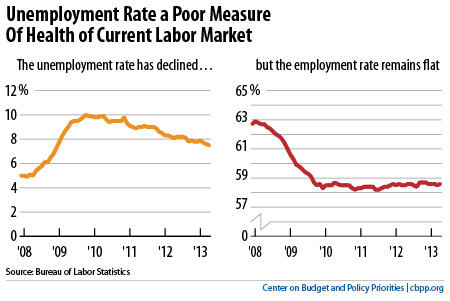off the charts
POLICY INSIGHT
BEYOND THE NUMBERS
BEYOND THE NUMBERS
Setting the Record Straight on SNAP, Part 4: Weak Job Market Keeping SNAP Enrollment High
Receive the latest news and reports from the Center
House Republican leaders don’t typically argue that there’s an abundance of jobs and that the economy is doing fine. Nevertheless, that line of argument seems to underlie their proposal to cut at least 2 million poor jobless workers from SNAP.
Noting that SNAP enrollment hasn’t fallen in tandem with the decline in the unemployment rate since the recession, they argue that SNAP’s growth in recent years is largely unrelated to the economy. But, in reality, SNAP enrollment — which has leveled off in recent months — remains high because the job market remains weak.

The unemployment rate is a poor measure of the health of today’s labor market, as our recent paper explains. The official unemployment rate does not include the large number of people who want a job — and in many cases would likely have found one in a stronger labor market — but, with jobs so hard to find, haven’t looked enough recently to count as officially unemployed.
The labor-force participation rate — the share of people aged 16 and over who are either working or officially unemployed — fell in the Great Recession and then continued to decline in the sluggish recovery. It is now at levels not seen since 1978.
As a result of the combination of a high unemployment rate and a low labor-force participation rate, the share of people aged 16 and over who have a job — what is often called the employment rate (or, more technically, the employment-population ratio) — plunged in the recession to levels not seen since the mid-1980s and has remained there.
Thus, while the official unemployment rate has fallen since late 2009, this masks the cold reality that the percentage of the adult population with a job is still stuck at levels it fell to when the economy hit bottom (see chart).
Moreover, history shows that declines in SNAP enrollment typically lag behind declines in the unemployment rate after recessions, in part because jobless people who can only find jobs with low wages and limited hours will often remain eligible for SNAP.
SNAP costs are expected to fall in coming years as the economy improves, as the next post in this series will explain. But if policymakers want to do more to lower SNAP costs, the best approach would be to aid the economic recovery to create jobs and boost incomes.
Next up: SNAP responded to the recession and will shrink as the economy improves.